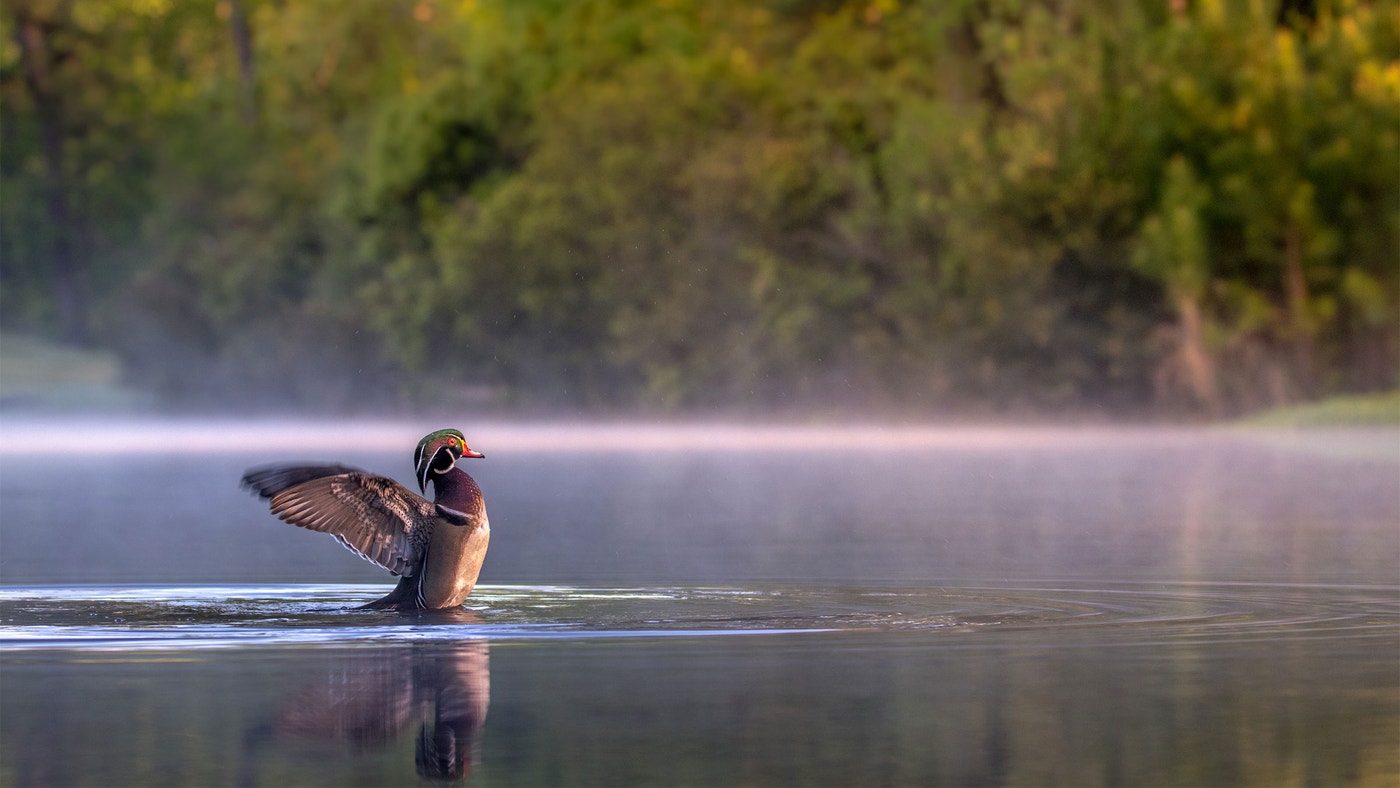
It’s hard to mistake a Wood Duck in the wild. From the kaleidoscopic male’s iridescent green crest and intricate markings to the female’s distinctive white eye patch, these birds are some of our most beautiful native waterfowl and always a treat to see. In fact, their scientific name, Aix sponsa, loosely translates to “bridal duck,” as the species—the male, particularly—is so well appointed that it appears dressed for a wedding. Such striking good looks have long made Wood Ducks a favorite of birders and a source of inspiration for artists and wood carvers.
Fortunately, these gorgeous birds are fairly easy to see throughout much of the United States and southern Canada. They live year-round along most of the Pacific Coast and in the Southern United States, and in the summer they can be found across the Eastern United States, Midwest, and Northwest. Northern migratory populations winter in the southern United States and in northern Mexico, where males and females pair up in advance of their return north each spring. Dive into the fun facts below to learn more about this truly stunning species.
1.) Wood Ducks owe their common name to the fact that they are one of the few waterfowl species that perch and nest in trees. Sharp nails on their webbed feet allow them to balance on branches and maneuver into tree cavities that they use for nesting.
2.) In some regions, the Wood Duck is also known as a Swamp Duck due to its preference for bottomland hardwood forests and swampy or marshy habitats with old-growth trees. Another nickname for the species is Squealer Duck, a reference to the toy-like squeaks heard in both the male and female’s calls.
3.) Wood Ducks prefer to nest in tree hollows, created either by Pileated Woodpeckers or, more often, the result of fallen tree branches. Due to wetland loss and competition from other species, natural tree hollows are becoming scarce, but Wood Ducks have happily used wooden nest boxes since they were first deployed in the 1930s to increase breeding success.
4.) The morning after hatching, ducklings take their first big plunge in life—through the air. Responding to calls from the mother duck, the chicks leap from nests as high as 50 feet above the ground or water. How do they survive? Downy feathers, pliable bones, and leaf litter provide the necessary cushion when not landing in water. (We highly recommend watching some videos of jumping and bouncing chicks for reference.)
5.) To increase their odds of nesting success, female Wood Ducks are the only North American waterfowl that regularly raise two broods in one year, often returning to the same nesting site to do so. Depending on how long the breeding season is in their home range, females typically lay their first clutch of eggs in late February through April and sometimes another clutch around May. Brood sizes vary from 6 to 16 eggs.
6.) While female Wood Ducks incubate most of their eggs themselves, they also dump some into neighboring nests, a practice known as brood parasitism. Scientists believe this to be another survival adaptation to maximize the chances of successful hatchings, and the behavior is more common when many suitable nests are in close proximity.
7.) In the fall and winter, adult Wood Ducks gorge on acorns due to their high fat content. In warmer months, mature ducks favor seeds and aquatic plants like duckweed, watermeal, and smartweed, which thrive in the slow-moving waters of their habitats. Ducklings feed exclusively on protein-rich insects and small invertebrates to fuel their development.
8.) The white teardrop pattern around a female Wood Duck’s eye is more than an elegant field mark: Researchers believe that the size of this eye patch signals age and reproductive potential for would-be mates. Older hens exhibit larger eye patches associated with reduced fitness and fertility.
9.) Wood Ducks are built to navigate the tight quarters of their preferred swampy habitat: A long, wide tail and powerful, broad wings allow them to nimbly fly through trees and branches, while their relatively large eyes absorb more light—useful for seeing under shaded conditions of dense forests.
10.) In the early 1900s, Wood Ducks were feared to be on the verge of extinction as a result of habitat loss and intense hunting. An artificial nest box program launched by the U.S. Fish and Wildlife Service and regulations like the Migratory Bird Treaty Act and Duck Stamp Act helped the birds begin to recover. The Wood Duck remains the second most popular hunting duck after the Mallard, but stronger protections for wetland ecosystems, like those that led to the formation of the National Wildlife Refuge System, have been vital to the thriving Wood Duck population we see today.

